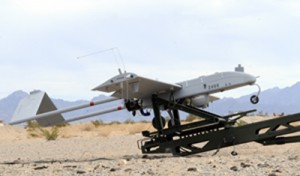Three naval entities collaborated to adapt a small radio receiver intended for space applications into a full-featured radio frequency system for a Marine Corps UAS. The Software Reprogrammable Payload (SRP), a joint effort between the Office of Naval Research, the Naval Research Laboratory and Marine Corps aviation, is currently targeted for the AAI Shadow.
Based on the successful development of SRP, Marine Corps aviation has included the capability in Programme Objective Memorandum (POM) 12 and 13. The programme of record officially starts in fiscal 2012 with transition funds expected in fiscal 2011.
SRP is a government-owned design for a flexible, reconfigurable-while-in-operation software radio developed to meet current and future needs for the Marine Corps’ UAS. It will be a complement to the military’s next-generation radio, the Joint Tactical Radio System, said John Moniz, ONR programme officer for command, control, computers and communication, expeditionary warfare/combating terrorism.
Two key elements of SRP are its non-proprietary design and a software developer’s tool kit that enables the widest community to develop applications.
“The software developer’s tool kit makes the cost of entry affordable,” Moniz said.
SRP will fill a technology gap enabling Marines on the ground to connect, via Shadow, with other warfighters regardless of the radio, network or waveform being used, said Lt. Col. Dean Ebert, Marine Corps Aviation Requirements Branch.
“The ability to reconfigure SRP’s function–while it is in flight or on a mission–ensures that Marines will be able to share knowledge, access capabilities, and effectively command while they manoeuvre and engage our adversaries,” Ebert said.
The collaborative work between ONR, NRL and the Marines played a significant role in making SRP a success, Marine Corps Lt. Gen. George Trautman, deputy commandant for aviation, said in a January 20, 2011, memo to ONR and NRL leadership.
The trio overcame several impediments that might have doomed most fledgling programmes and instead moved SRP to the “cusp of transition with a funding line in place,” Trautman said before retiring from the Corps in February.
The partnership among ONR, NRL and Marine aviation has been remarkable, and ONR’s contribution to the success of SRP cannot be overstated, Ebert added.
“Each organization has–without ego–contributed significantly: ONR accepted early risk and funded this project and provided programme oversight and leadership; Marine aviation defined a transition path and established the appropriate requirements; and NRL has adroitly managed the programme,” Ebert said.
For its part, ONR restructured resources, formed an SRP team and delivered a noteworthy product, said Ashley Johnson, ONR’s director of applications, expeditionary manoeuvre warfare and combating terrorism.
“ONR was responsive to the requirement. It is a good utilization of our resources,” Johnson said. “That’s an important message.”
As it stands now, SRP has not been deployed into theatre as a Marine asset, Ebert said. “We are still in development, with a (low rate) initial production run slated to start at the end of this year as we wrap up our testing.”
The original goal was to provide the Marines with a robust, flexible payload for the Shadow UAS starting with four applications: A Single Channel Ground and Airborne Radio System communications relay; Bent Pipe UHF Communications; UHF Internet Protocol router for legacy tactical UHF radios; and automated identification system (AIS) as the notional signals intelligence application.
SRP is planned to transition into Integrator, the Marine Corps’ small tactical UAS, Moniz said.
Provided by Office of Naval Research

